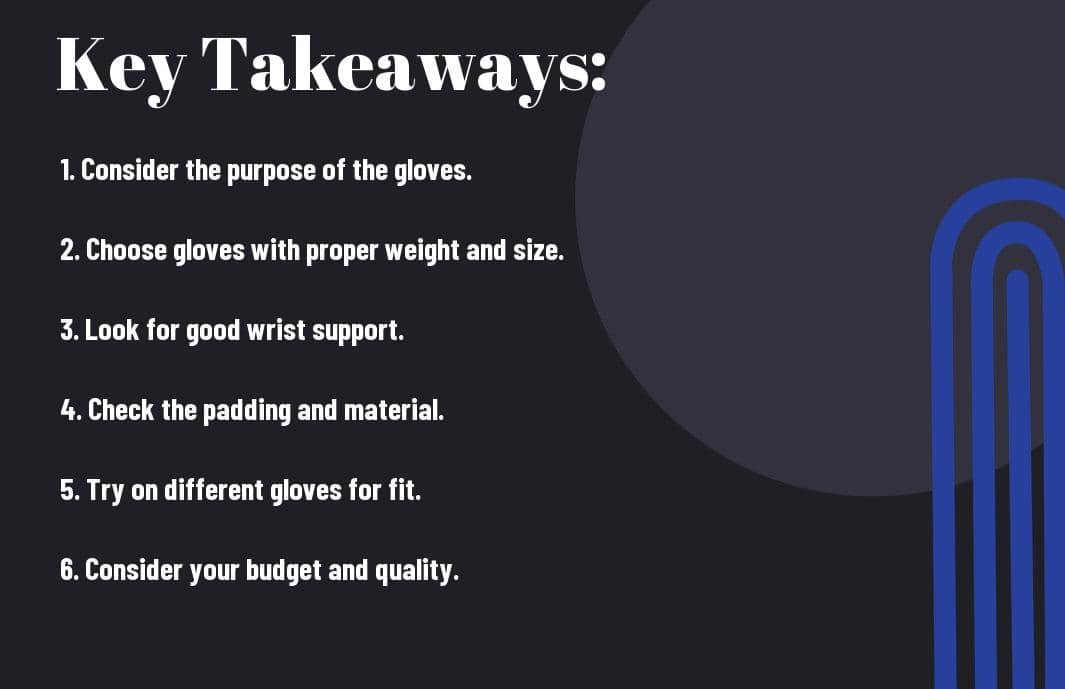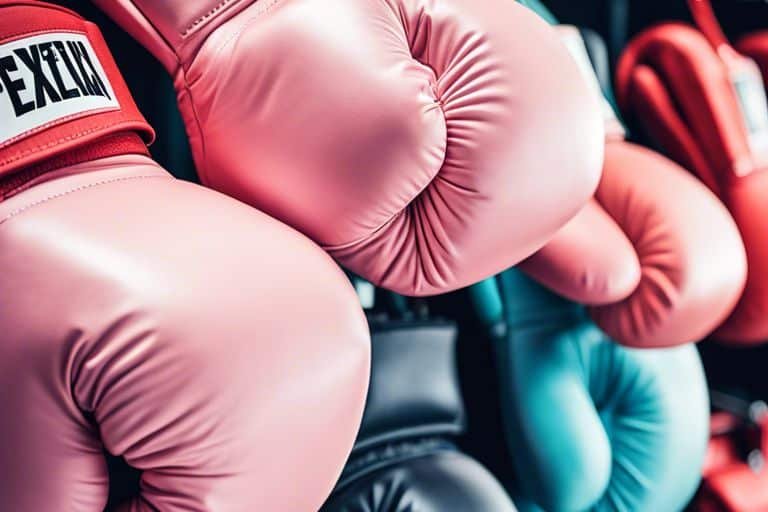So, you’ve decided to take your boxing training to the next level and invest in a pair of proper gloves. Choosing the right gloves is crucial for both your performance and safety in the ring. There are several factors to consider, such as the weight of the gloves, the type of training you’ll be doing, and the fit of the gloves. In this blog post, we’ll guide you through the process of selecting the perfect pair of gloves to suit your boxing needs.
Key Takeaways:
- Consider the type of boxing training: Before choosing gloves, consider the type of training you will be doing, such as sparring, bag work, or pad work. Each type may require different glove specifications.
- Choose the right glove weight: The glove weight you choose should correspond to your body weight and the type of training you will be doing. Heavier gloves offer more protection, while lighter gloves offer more speed and agility.
- Prioritize hand protection: Look for gloves with ample padding around the knuckles and wrists to protect your hands from impact and prevent injury during training sessions.
- Ensure a proper fit: Your gloves should fit snugly without constricting blood flow. Properly fitted gloves can improve your performance and reduce the risk of injury.
- Quality and Durability: Invest in high-quality gloves that are durable and will withstand the rigours of regular training. A good pair of gloves will last longer and provide better protection.

Factors to Consider When Selecting Boxing Gloves
When choosing the right boxing gloves for your training, there are several important factors to take into consideration. Here are some key factors to keep in mind:
Glove Size and Weight
One of the most crucial aspects of selecting the right boxing gloves is ensuring that you choose the correct size and weight. How do you pick the right size boxing gloves? This can impact the effectiveness of your training and prevent injury. You should consider your body weight, the type of training you will be doing, and whether you will be using the gloves for sparring or bag work.
Material and Quality
When it comes to boxing gloves, the material and quality of construction are vital. High-quality leather gloves offer greater durability and protection for your hands, while cheaper materials may wear out quickly and provide inadequate support. The right material and construction can make a significant difference in your training experience.
Closure Types: Lace-ups vs. Velcro
Choosing between lace-up and Velcro closure types is a decision that should not be taken lightly. Both options have their own benefits and drawbacks, and the choice you make will largely depend on your specific training needs and personal preferences. Consider the following:
- Lace-up closure: Provides a snug and secure fit, but may require assistance to put on and take off.
- Velcro closure: Offers convenience and easy adjustability, but may not provide as customised a fit as lace-ups.
Though a careful selection between these two closure types can significantly impact your training sessions.
Brand and Budget Considerations
Finally, you should consider the reputation of the boxing glove brand and how it aligns with your budget. While it’s important to invest in a high-quality pair of gloves to ensure your safety, there are also various options available to suit different budgets. Ultimately, finding a balance between brand reputation and your budget is essential for making a well-informed decision.
Types of Boxing Training and Glove Suitability
When choosing the right gloves for boxing training, it’s essential to consider the specific type of training you will be undertaking. Each type of training requires gloves with different features and padding to ensure your hands are protected and you have the support you need. Let’s break down the different types of boxing training and the glove suitability for each.
| Training Type | Suitable Gloves |
|---|---|
| Bag Work | Heavy bag gloves or training gloves |
| Sparring | Sparring gloves |
| Competitive Fights | Competition gloves |
Gloves for Bag Work
When it comes to bag work, you need gloves that can provide adequate wrist support and padding to protect your hands when hitting the heavy bag. Look for heavy bag gloves or training gloves with a thick layer of foam padding to absorb the impact of your punches. These gloves should also have a secure wrist closure to keep your wrists stable and reduce the risk of injury.
Gloves for Sparring
Sparring requires a different type of glove to ensure safety for both you and your sparring partner. Sparring gloves are designed with softer padding to lessen the impact of your punches and reduce the risk of injury to your partner. These gloves should also have a larger surface area to help you make contact more comfortably and a secure wrist closure for stability during training.
Gloves for Competitive Fights
When it comes to competitive fights, you need gloves that are approved for use in professional boxing matches. Competition gloves are designed to provide maximum hand protection while meeting the safety regulations set by boxing authorities. These gloves also offer a snug fit and optimal padding to ensure your hands are well-protected during intense bouts.
Proper Fit and Comfort
When it comes to boxing gloves, the right fit is crucial. Ill-fitting gloves can lead to discomfort, reduced performance, and even injury during training. Your gloves should feel snug and secure without being too tight, allowing for proper hand movement and flexibility. Comfort is also key, as you will be wearing your gloves for extended periods during training sessions.
How to Measure Your Hands for Boxing Gloves
Measuring your hands for boxing gloves is essential to ensure a proper fit. To do this, use a tape measure to measure the circumference of your dominant hand around the knuckles, excluding the thumb. Once you have this measurement, refer to the sizing chart provided by the glove manufacturer to determine the correct glove size for your hand.
The Role of Hand Wraps in Boxing Training
Hand wraps play a significant role in boxing training by providing added support and protection to your hands and wrists. They help to stabilise the hand and wrist, reducing the risk of injury from impact during training. Wearing hand wraps also helps to absorb sweat and moisture, keeping your gloves dry and enhancing comfort during your workouts.
By ensuring proper fit and comfort, measuring your hands for the right glove size, and understanding the importance of hand wraps in boxing training, you can maximise your performance and reduce the risk of injury. Remember, your gloves should feel snug and secure, your hand wraps should provide support and protection, and together they should enhance your overall training experience. Don’t compromise on the fit and comfort of your boxing gloves, as this can have a significant impact on your training and performance.
Maintenance and Longevity of Boxing Gloves
When it comes to investing in a pair of boxing gloves, it’s important to ensure that you are taking proper care of them to maximise their longevity. Proper maintenance not only ensures that your gloves last longer, but it also helps to maintain their performance and hygiene.
Cleaning and Storage Tips
Keeping your boxing gloves clean is essential for both hygiene and the durability of the gloves. After each training session, wipe down the exterior of the gloves with a dry cloth to remove any sweat and moisture. You can also air the gloves out by leaving them in a well-ventilated area or using a glove deodoriser. When it comes to storage, make sure to keep your gloves in a cool, dry place. Avoid leaving them in a damp environment, such as a gym bag, as this can lead to the growth of bacteria and unpleasant odours. It’s also a good idea to invest in a glove dehumidifier or bag to help absorb any excess moisture. This will help to prevent the build-up of bacteria and keep your gloves smelling fresh.
- Wipe down gloves after each use
- Air out gloves after use
- Store in a cool, dry place
- Invest in a glove dehumidifier or bag
This will help to maintain the freshness and longevity of your gloves, keeping them in top condition for your training sessions.
When to Replace Your Gloves
Knowing when it’s time to replace your boxing gloves is crucial for both your performance and safety. Over time, the padding in the gloves will begin to degrade, resulting in reduced protection for your hands. If you notice that the padding has become compressed or the stitching is coming apart, it’s time to invest in a new pair of gloves. Additionally, if you start to experience discomfort or pain during training, it may be a sign that your gloves are no longer providing adequate support and protection. As a general rule, it’s recommended to replace your boxing gloves every 6 months to 1 year, depending on the frequency of use and the intensity of your training sessions.
How Do I Choose the Right Gloves for Boxing Training?
Presently, you should know how to choose the right gloves for your boxing training. Consider factors such as size, weight, and material when selecting your boxing gloves. Remember that the right gloves will provide protection and support for your hands and wrists, and will contribute to the effectiveness of your training. By following these guidelines, you can ensure that you are selecting the best gloves for your boxing needs.
FAQ
Q: What factors should I consider when choosing boxing gloves for training?
A: When choosing boxing gloves for training, you should consider factors such as the size and weight of the gloves, the type of training you will be doing, the material of the gloves, and the level of protection and support they offer.
Q: What is the difference between glove sizes?
A: Boxing glove sizes are measured in ounces (oz). The size of the glove you choose should depend on your body weight and the type of training you will be doing. Heavier gloves provide more protection and are typically used for sparring, while lighter gloves are used for pad work and bag work.
Q: What type of training will I be doing?
A: The type of training you will be doing will determine the type of gloves you should choose. If you will be sparring, you will need heavier gloves with more padding. If you will be doing pad work or bag work, you can use lighter gloves.
Q: What material should I look for in boxing gloves?
A: Boxing gloves are typically made of either leather or synthetic materials. Leather gloves are more durable and provide better support, while synthetic gloves are more affordable and easier to clean.
Q: What level of protection and support should I look for in boxing gloves?
A: The level of protection and support you need will depend on your experience level and the intensity of your training. If you are a beginner, you will need gloves with more padding and wrist support. More experienced boxers may opt for gloves with less padding for increased speed and mobility.
Q: How do I ensure a proper fit for boxing gloves?
A: To ensure a proper fit for boxing gloves, try them on and make a fist to ensure they are not too tight or too loose. The gloves should feel snug but not uncomfortable, and your fingers should be able to move freely.
Q: What is the importance of hand wraps when using boxing gloves?
A: Hand wraps are essential when using boxing gloves as they provide additional wrist and hand support, and help to protect your hands and wrists from injury during training. Always use hand wraps in conjunction with boxing gloves for added protection.



